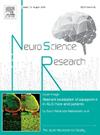Possible role of mosaic mutations of neurodevelopmental disorder-related genes in bipolar disorder: Lessons from Kmt2c chimeric heterozygous knockout mice
IF 2.3
4区 医学
Q3 NEUROSCIENCES
引用次数: 0
Abstract
We recently found a loss of function mosaic mutation of KMT2C, a causative gene for autism spectrum disorder and Kleefstra syndrome, in a patient with bipolar disorder and reported that somatic mutations in neurodevelopmental disorder-related genes are increased in bipolar disorder by deep exome sequencing analysis. However, causal roles of neurodevelopmental disorder-related mutations in bipolar disorder, a qualitatively different mental disorder, are not known. In this study, we focused on a loss of function mutation of Kmt2c, that causes autism-like phenotypes in mice. To simulate a mosaic mutation found in the patient, we generated mosaic Kmt2c knockout mice using conventional chimera mice technology. We showed that the mosaic Kmt2c knockout mice did not show autism-like behavior but presented anxiety disorder-like symptom, which is avoidance to a corner where the mice previously experienced air puff. The rate of depression-like episodes measured by wheel running recording did not differ from control mosaic mice. These results suggest that mosaic mutations of neurodevelopmental disorder-related genes can cause qualitatively different anxiety disorder-like phenotypes. Because anxiety is one of symptomatic spectrum of bipolar disorder, these findings support the role of mosaic mutations of neurodevelopmental disorder-related genes as a component of the genetic architecture of bipolar disorder.
神经发育障碍相关基因镶嵌突变在双相情感障碍中的可能作用:来自Kmt2c嵌合敲除小鼠的经验教训。
我们最近在一名双相情感障碍患者中发现了自闭症谱系障碍和Kleefstra综合征的致病基因KMT2C的功能缺失镶嵌突变,并报道了通过深度外显子组测序分析,神经发育障碍相关基因的体细胞突变在双相情感障碍中增加。然而,神经发育障碍相关突变在双相情感障碍(一种性质不同的精神障碍)中的因果作用尚不清楚。在这项研究中,我们关注的是导致小鼠自闭症样表型的Kmt2c功能缺失突变。为了模拟在患者身上发现的嵌合体突变,我们使用传统的嵌合体小鼠技术产生了嵌合体Kmt2c敲除小鼠。我们发现马赛克Kmt2c基因敲除小鼠没有表现出自闭症样的行为,但表现出焦虑障碍样的症状,即回避小鼠以前经历过的一个角落。通过滚轮跑步记录测量的抑郁样发作率与对照马赛克小鼠没有差异。这些结果表明,神经发育障碍相关基因的马赛克突变可以引起质量上不同的焦虑样表型。由于焦虑是双相情感障碍的症状谱之一,这些发现支持了神经发育障碍相关基因的马赛克突变作为双相情感障碍遗传结构的一个组成部分的作用。
本文章由计算机程序翻译,如有差异,请以英文原文为准。
求助全文
约1分钟内获得全文
求助全文
来源期刊

Neuroscience Research
医学-神经科学
CiteScore
5.60
自引率
3.40%
发文量
136
审稿时长
28 days
期刊介绍:
The international journal publishing original full-length research articles, short communications, technical notes, and reviews on all aspects of neuroscience
Neuroscience Research is an international journal for high quality articles in all branches of neuroscience, from the molecular to the behavioral levels. The journal is published in collaboration with the Japan Neuroscience Society and is open to all contributors in the world.
 求助内容:
求助内容: 应助结果提醒方式:
应助结果提醒方式:


